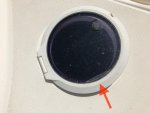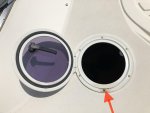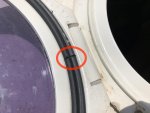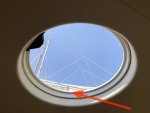iapetus
Active Member
Dear forum,
It's been raining cats, dogs and Saharian sand since the so-called spring season started, and I recently found a leak that developed around the starboard hatch.
Here is the offending hatch, dirty from "gabian" (vernacular name of these large, aggressive seagulls) mess and last night rain. The water accumulates under the arrow, that is, towards the the starboard side of the boat, due to the slight gradient of the deck.

Same thing, now opened. Some water can be seen where it accumulates

A closer look at the seal. Its seems broken, doesn't it?

Seen from the inside of the boat, arrow points to where the water is leaking. I noted that water was leaking inside the hatch, not around it.

Its port sibling has the same kind of somewhat broken seal, but doesn't leak at all. What could be the cause then ? The broken seal anyway, as shown on the third picture ? A bad mechanical adjustment that prevent the seal from playing its full role ?
Thanks!
It's been raining cats, dogs and Saharian sand since the so-called spring season started, and I recently found a leak that developed around the starboard hatch.
Here is the offending hatch, dirty from "gabian" (vernacular name of these large, aggressive seagulls) mess and last night rain. The water accumulates under the arrow, that is, towards the the starboard side of the boat, due to the slight gradient of the deck.

Same thing, now opened. Some water can be seen where it accumulates

A closer look at the seal. Its seems broken, doesn't it?

Seen from the inside of the boat, arrow points to where the water is leaking. I noted that water was leaking inside the hatch, not around it.

Its port sibling has the same kind of somewhat broken seal, but doesn't leak at all. What could be the cause then ? The broken seal anyway, as shown on the third picture ? A bad mechanical adjustment that prevent the seal from playing its full role ?
Thanks!
